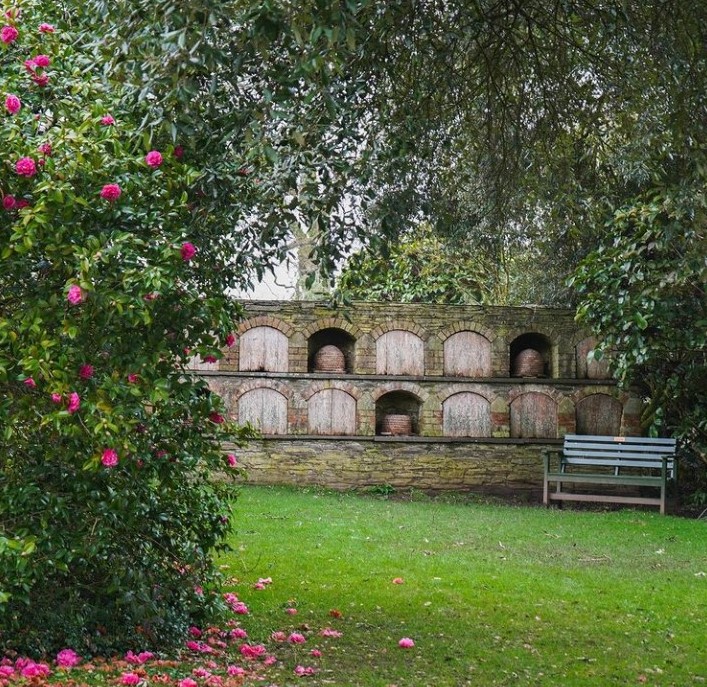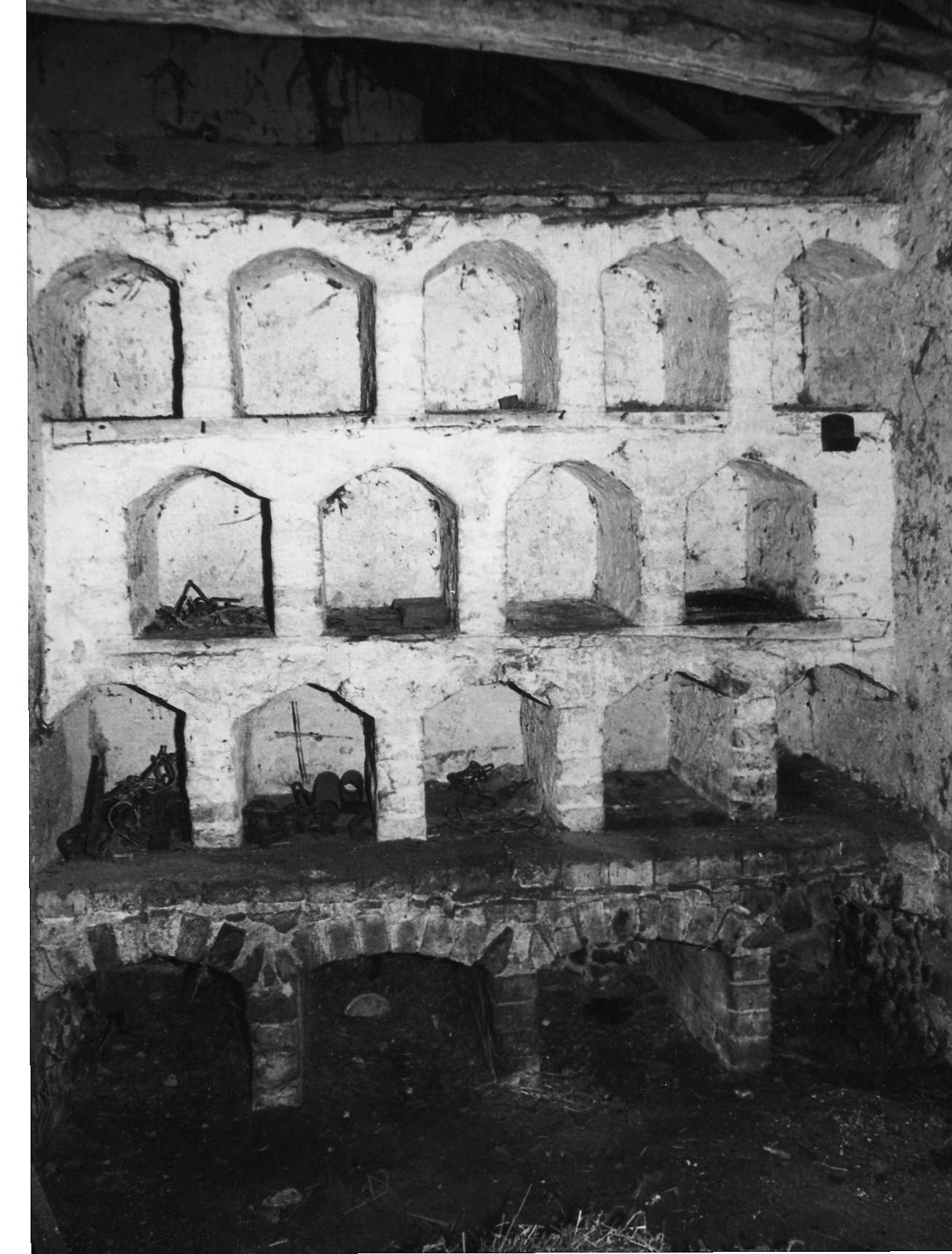What are Bee Boles?
Bee Boles are rows of recesses, typically found in south-facing garden walls. Each recess was designed to accommodate a skep, the traditional coiled-straw hive used by beekeepers in Britain before the advent of modern wooden hives in the late 19th century. Skeps were up to about 12 inches (c. 30 cm) in diameter and similar in height. See the Historical Collection for various examples.
Types of structures to protect skeps of bees
Bee boles
These are defined as one or more recesses in a wall, in which skeps of bees were kept, to protect them from prevailing wind and rain.
This fine example is located in the beautiful Heligan Gardens, St Austell, Cornwall. There are 2 rows of 7 recesses set in the wall. Each bole has a pivoted wooden door, which is closed during the winter. However, the majority of bee boles don’t have this additional feature! (Register no. 0356.)
Image credit: @heligangardens
 Bee shelter
Bee shelter
This is a roofed wooden or stone structure which is either built against a wall or is free-standing. The skeps were kept on one
or more shelves.
This example of a simple stone shelter is located in Cumbria. (e.g. Register No. 0210).
 Alcove
Alcove
This is a large recess, usually in a wall and usually with a vaulted top. It is likely to contain one or more shelves for skeps.
There are several examples in the register, but this image is taken of an elaborate structure at Daresbury Hall in Cheshire.
The Hall was built in 1759, and this alcove is said to date back to between 1760 and 1775. (Register No. 0016)
Bee house
This is a free-standing roofed building with internal shelves or recesses for skeps, and entrance holes or tunnels through the wall(s) for the bees.
Some structures, such as the image shown, were large enough for the beekeeper to work inside the building.
This example is located at Tayfield House, Fife, Scotland. It was constructed in the 1800’s and still has brightly coloured landing boards for the bees.(e.g. Register No. 1543)
 Winter storage
Winter storage
This is usually a dark building containing recesses or shelves where colonies in skeps were kept in winter. This would help
to maintain a more equable temperature, when the bees were inactive and so preserve their energy.
This example is located at a property in Norfolk and probably dates from the early 1900s (Register No. 0859).
William Cotton, an Oxford beekeeper writing in 1842 said:
“The best place to put Bees in is a dry, cold, and dark room, or outhouse, ... Put your Bees there the last week of November,
and let them sleep quietly till the flowers begin to come out at the end of February”
About the Register.
Started by Dr Eva Crane in 1952, the Register now contains records for over 1600 sites across the UK and Ireland and has images for most of them. To improve accessibility to the records and to encourage conservation and further recording, the Register was put into a database and made available online in 2005. This work was undertaken by Penny Walker (Trustee of the Eva Crane Trust), who also maintained the register which was part of the International Bee Research Association (IBRA).
In 2022, IBRA handed over the care and maintenance of the Bee Boles Register to the Eva Crane Trust. The archival paper records are now housed at the National Library of Wales, Aberystwyth, (www.library.wales) which will make these archives accessible to researchers.
Records for sites in France and other European countries were given to Apistoria in 2001.
Use of the Bee Boles Register, intellectual property rights and privacy
All data, images and information in this web site (together with all intellectual property in the document) are the property of the ECT, except where a copyright symbol © appears. All rights reserved. (Please note that "© Crown copyright: RCAHMW" indicates "© Crown copyright: Royal Commission on the Ancient and Historical Monuments of Wales".)
The Register is freely available for personal viewing and research purposes. However, prior permission must be obtained from the ECT — or copyright holders if indicated — for use of any part of this website for any other purposes.
The Register database complies with the Data Protection Act 2018.
Contact details such as email addresses supplied by recorders, are not made available on the website or to third parties and will be retained only for as long as is necessary to create or edit a record. The Register is held on a secure database.
Visiting sites
A few of the structures are accessible to the public, for example at National Trust properties, but the majority are on private property. For the latter, it is essential that anyone wanting to view a particular structure first gains permission from the owner.
Dimensions
Measurements were made in feet and inches when recording started in 1952, and this continued after metrication. So that comparisons can be made, the dimensions given in the Register database are all non-metric. (1 inch = 2.54 cm; if converting, bear in mind that the metric dimensions obtained are over-exact for the structures.)
Acknowledgements
The Register would not exist without the foresight and work of:
- Dr Eva Crane, whose interest in traditional beekeeping structures continued for over 50 years, until her death on 6 September 2007.
- Penny Walker, who has tirelessly continued Dr Crane's work and brought the Register online in 2005.
- Emma Trevarthen, who managed and updated the Register as a volunteer between 2017 - 2023.
- The many local historians and house-owners who have sent in records, too numerous to list here. Their valuable contributions are gratefully acknowledged.
Other useful sources of information:
https://historicengland.org.uk/ Historic England
CADW (Welsh Historic Monuments), Cardiff
Historic Scotland, Edinburgh

